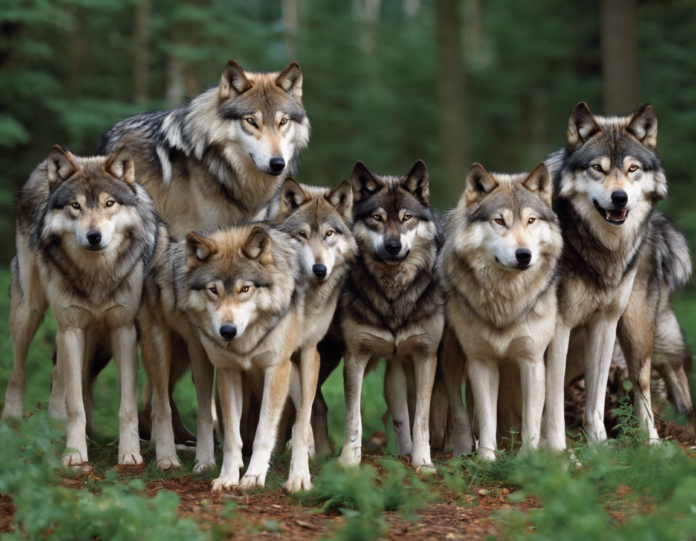Wolves are fascinating and highly social animals that are known for their strong sense of family and community. One of the most captivating aspects of wolves is their tendency to travel in groups, which are often referred to by a specific term. So, what is a group of wolves called?
A group of wolves is typically known as a pack. Within a wolf pack, there is a complex social structure and hierarchy that dictates the interactions and behaviors of the individual members. Let’s delve deeper into the concept of wolf packs and explore the intricacies of these tight-knit communities in the wild.
The Dynamics of a Wolf Pack
Hierarchy and Leadership
In a wolf pack, there is a well-defined hierarchy that establishes the leadership roles among the members. At the top of the hierarchy is the alpha pair, which consists of the dominant male and female wolves. These alpha wolves are usually the breeding pair and have the highest rank in the pack.
Below the alpha pair are the beta wolves, which are subordinate to the alphas but still hold a higher rank than the rest of the pack. Beta wolves play essential roles in maintaining order within the pack and supporting the alphas in decision-making.
Further down the hierarchy are the omega wolves, which are the lowest-ranking members of the pack. Omega wolves may face social challenges within the group and are often subjected to bullying or exclusion by higher-ranking individuals.
Social Bonding and Cooperation
Wolves rely on their pack for survival, as cooperation and teamwork are crucial for hunting, raising young, and defending territories. By working together, wolves can take down large prey, such as elk or bison, that would be challenging for a single wolf to tackle alone.
Pack members also engage in social behaviors like grooming, playing, and communicating through body language, vocalizations, and scent markings. These interactions help strengthen the bonds between pack members and foster a sense of unity within the group.
Pack Size
The size of a wolf pack can vary depending on factors like food availability, habitat quality, and pack dynamics. A typical wolf pack may consist of 6 to 10 individuals, but larger packs with up to 30 wolves have been documented in certain environments.
The Role of Wolves in Ecosystems
Wolves play a vital role in maintaining ecosystem health and balance. As apex predators, wolves help regulate prey populations, prevent overgrazing, and indirectly benefit other species by shaping the structure of the food web.
By controlling herbivore populations, wolves can have far-reaching effects on vegetation, soil health, and even the behavior of other predators in the ecosystem. This phenomenon, known as a trophic cascade, underscores the interconnectedness of species within an ecosystem.
Wolves’ presence can also lead to more diverse and resilient ecosystems, as their hunting behavior influences the spatial and temporal distribution of prey species, ultimately shaping the landscape in ways that benefit biodiversity.
In areas where wolves have been reintroduced after extirpation, researchers have observed positive ecological effects, including the recovery of vegetation, improved water quality, and increased biodiversity.
Human-Wolf Interactions
Despite their ecological importance, wolves have historically faced persecution from humans due to conflicts over livestock depredation, competition for resources, and fear of predation. This has led to the decline and extirpation of wolf populations in many regions.
However, attitudes towards wolves are evolving, and conservation efforts are underway to protect and restore wolf populations worldwide. Through education, research, and proactive management strategies, conservationists are working to promote coexistence between wolves and humans.
Frequently Asked Questions (FAQs)
-
Do wolves always travel in packs?
Wolves are social animals that typically live in packs, but some individuals may roam alone or form smaller groups known as wolfs. -
What is the average lifespan of a wolf in the wild?
Wolves in the wild can live 6 to 8 years, although some individuals have been known to reach their early teens. -
How far can a wolf pack travel in a day?
A wolf pack can cover vast distances in search of food, with daily movements ranging from 8 to 30 miles depending on factors like prey availability. -
Are there different types of wolves around the world?
Yes, there are several subspecies of wolves, including the Gray Wolf, Arctic Wolf, Red Wolf, and Mexican Wolf, each adapted to specific habitats. -
Do wolves mate for life?
The alpha pair in a wolf pack typically forms a long-term bond and may mate for life, although circumstances like the death of a mate can lead to new pairings. -
How do wolves communicate within a pack?
Wolves use a combination of vocalizations (howls, barks, growls), body language (postures, facial expressions), and scent marking to convey information and maintain social cohesion. -
What threats do wolves face in the wild today?
Wolves are threatened by habitat loss, human persecution, poaching, disease, and conflicts with livestock, all of which contribute to the ongoing conservation challenges facing wolf populations. -
Are wolves endangered species?
While certain wolf populations are considered endangered or threatened, conservation efforts have helped some species rebound in certain regions, highlighting the importance of ongoing conservation initiatives. -
Can wolves be domesticated?
Wolves are wild animals and not suitable for domestication in the same way as dogs. However, some wolf hybrids have been bred as pets, though they require specialized care and handling due to their wild instincts. -
What can I do to support wolf conservation efforts?
You can support wolf conservation by staying informed, advocating for habitat protection, engaging in responsible wildlife viewing practices, and supporting organizations dedicated to wolf conservation and research.
In conclusion, the concept of a wolf pack represents the intricate social structure and cooperative behaviors that define these remarkable carnivores. By understanding the dynamics of wolf packs and the critical role of wolves in ecosystems, we can appreciate and work towards the conservation of these iconic species.





